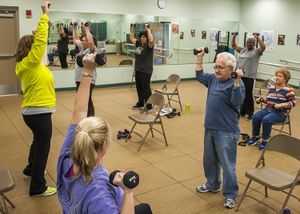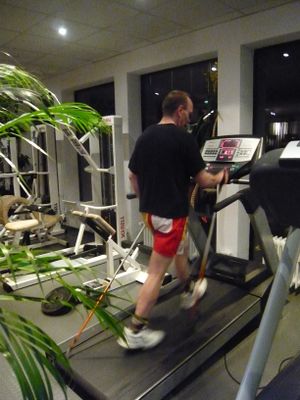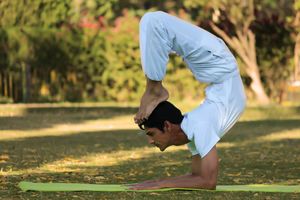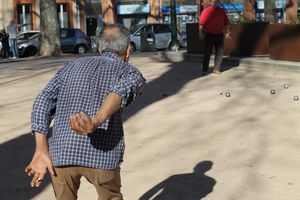Therapeutic Exercise
Original Editor - User:Lucinda hampton
Top Contributors - Inga Balciuniene, Lucinda hampton, Kim Jackson, Kapil Narale, Candace Goh, Angeliki Chorti, Yahya Al-Razi and Aminat Abolade
Introduction[edit | edit source]
In the simplest terms, therapeutic exercise involves movement prescribed to correct impairments, restore muscular and skeletal function and/or maintain a state of well-being[1].The scientific evidence demonstrating the beneficial effects of exercise is indisputable, and the benefits of exercise far outweigh the risks in most adults. For most adults, an exercise program including aerobic, resistance, flexibility, and neuromotor exercise training is indispensable to improve and maintain physical fitness and health[2].
Therapeutic exercise is one of the core skills upon which the profession of physiotherapy is based. By considering definitions of therapeutic exercise, physical activity and exercise, it is possible to see that, although therapeutic exercise contains the components of both physical activity and exercise, it also provides a systematic exercise programme for remediation of impairments and improvement of function[3].
What is the difference between physical activity and exercise? Physical activity refers to the contraction of skeletal muscle that produces bodily movement and requires energy. Exercise is physical activity that is planned and is performed with the goal of attaining or maintaining physical fitness. Physical fitness is a set of traits that allows an individual to perform physical activity[4].
Types of exercises[edit | edit source]
Therapeutic exercise may include: aerobic and endurance conditioning and reconditioning; agility training; body mechanics training; breathing exercises; coordination exercises; developmental activities training; muscle lengthening; movement pattern training; neuromotor development activities training; neuromuscular education or reeducation; perceptual training; range of motion exercises and soft tissue stretching; relaxation exercises; and strength, power, and endurance exercises.[5]
The most commonly included exercises fall into 4 groups
- Strengthening exercises, usually performed with heavy resistance and fewer repetitions.
- Endurance exercises that engage large muscle groups over a longer period of time, in the area of 50 to 60% VO2Max to achieve greater cardiovascular endurance[1].
- Flexibility exercises achieved through stretching and movement.
- Balance and coordination exercises that focus on maintaining an individual's centre of gravity.
All of these are combinable into exercise programs that work for many different types of patients. Different subtypes of exercises can help to increase effectiveness or allow participation of individuals with special needs based on comorbidities. eg. aquatic therapy for stroke patients with balance difficulties
Basic exercise prescriptions should follow the FITT mnemonic.
F- frequency: number of days per week
I- Intensity: low, moderate or vigorous
T- Time: minutes per session for endurance exercise
T- Type: endurance, strength, flexibility or some combination[5]
Strengthening Exercises[edit | edit source]
Strength training is done to build up muscle tissue; it typically consists of graded exercises involving resistance training. Strength training may be high or moderate in intensity.[6]
This modality increases overall strength and comes in three forms: isotonic, isometric, and isokinetic.
- Isotonic consists of dynamic movements with a constant load.
- Isokinetic involves a constant velocity with variable load.
- Isometric involves muscle contraction that is static with no change in muscle length.
All forms of resistance training have favorable effects on diabetes, osteoporosis, and cancer with increases in bone mineral density, increased bowel transit time, increased glucose uptake in muscle, and improvements in back pain[1] and for seniors because (most persons lose between 20 and 40 percent of their muscle tissue as they age)[6].
Endurance Exercises[edit | edit source]
Endurance exercises provide the best-documented benefits of therapeutic exercise for the elderly and those with chronic health condition.
- Walking is the most common form of endurance exercise practiced and it is the one most frequently recommended by doctors. Walking can be easily incorporated into the daily schedule. One study showed that seniors who walk at least 2 miles a day on average lower their mortality risk by 50 percent.
- Other good forms of endurance training are swimming, cycling, dancing, walking up stairs instead of taking the elevator, golf (walking), gardening or heavy yard work, and low-impact aerobics.[6]
The target heart rate for moderate-intensity endurance exercise is 60 to 79 percent of maximal heart rate (measured in beats per minute). Maximal heart rate, which is usually determined by an exercise stress test , can also be calculated by subtracting the persons age from 220.
Flexibility Exercises[edit | edit source]
Flexibility training: slowed, controlled exercises performed in a gradual manner (usually in the increment of fifteen to thirty seconds) that aid in the range of motion at joints or series of joints. Three main types exist: static, dynamic, and PNF (proprioceptive neuromuscular facilitation).
- Static involves held positions that are effective with little required in terms of assistance and time.
- Dynamic involves repetitive bouncing movements that produce muscle stretch over time.
- PNF involves alternating contraction and relaxation of agonist/antagonist muscles at specific joints that generally produce the largest increase in flexibility.[1]
Balance and Co-ordination[edit | edit source]
Balance exercises are important for those with de-conditioning because they lower the risk of falls—a major cause of disability.
Balance exercises include eg
- Tandem stance
- Perturbation Exercises
- Otago Exercise Program
- Single keg stance - standing with hands on a table for balance and slowly stands on tiptoe, holding the position for 1 second and repeating the motion 8 to 15 times. Gradually working up to holding the table only with a fingertip, then with no hands, then with eyes closed.
- Walking heel to toe for short distances.
- Altered surfaces eg balance boards, grass.
- Altered gait eg backwards walking, walking and ball tossing, figure 8 walking.
Physiotherapy[edit | edit source]
Exercise programs require individualization according to the age of the patient, severity of condition, and/or comorbid disease.[1]
Physical therapists select, prescribe, and implement therapeutic exercise activities when the examination findings, diagnosis, and prognosis indicate the use of these activities.
Fully evaluate all persons beginning an exercise prescription or regimen with a focus on specific risk factors that they may have eg the acuity of condition, the type of disease, comorbid factors.
The chosen exercises may provide the following benefits: enhance bone density; enhance breathing; enhance or maintain physical performance; improve safety; increase aerobic capacity/endurance; increase muscle strength, power, and endurance; enhance postural control and relaxation; increase sensory awareness; increase tolerance of activity; prevent or remediate impairments in body functions and structures, activity limitations, and participation restrictions to improve physical function; enhance health, wellness, and fitness; reduce complications, pain, restriction, and swelling; or reduce risk and increase safety during activity performance.[5]
- For cardiac and pulmonary rehabilitation, there is an interprofessional requirement for Physical therapists, occupational therapists, and all levels of clinical involvement due to the acuity of patients involved.
- For individual sports injuries, only physical therapists may be necessary to guide the patient through specific regimens. Incorporating home exercises that are easy and safe to perform alone allows peripheral surveillance with minimal risk.[1]
References[edit | edit source]
- ↑ 1.0 1.1 1.2 1.3 1.4 1.5 Bielecki JE, Tadi P. Therapeutic Exercise. InStatPearls [Internet] 2020 Mar 19. StatPearls Publishing. Available from:https://www.ncbi.nlm.nih.gov/books/NBK555914/ (last accessed 24.5.2020)
- ↑ Garber CE, Blissmer B, Deschenes MR, et al. American College of Sports Medicine position stand. The quantity and quality of exercise for developing and maintaining cardiorespiratory, musculoskeletal, and neuromotor fitness in apparently healthy adults:guidance for prescribing exercise. Med Sci Sports Exerc. 2011;43(7):1334–59.
- ↑ Glynn A, Fiddler H.The Physiotherapist's Pocket Guide to Exercise Assessment, Prescription and Training,Churchill Livingstone, 2009.
- ↑ Eric H, Gary J. Exercise and the Heart.Cardiology Secrets (Third Edition)2010, Pages 311-315
- ↑ 5.0 5.1 5.2 Guide to practice. Therapeutic exercise Available from:http://guidetoptpractice.apta.org/content/1/SEC40.extract (last accessed 24.5.2020)
- ↑ 6.0 6.1 6.2 Encyclopedia Therapeutic exercises Available from:https://www.encyclopedia.com/caregiving/encyclopedias-almanacs-transcripts-and-maps/therapeutic-exercise (last accessed 25.4.2020)













